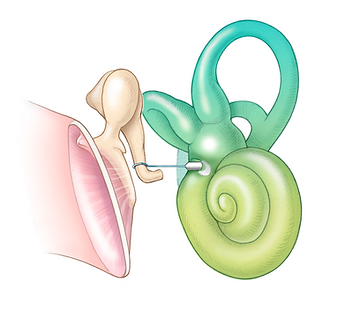Aaron Trinidade, FRCS (ORL-HNS)
ENT Surgeon
Providing exceptional care for your ears, nose & throat

Helen Frankel: 07968312069
Private Secretary
Otosclerosis
What is otosclerosis?
Otosclerosis is a bony abnormality of the inner ear, mainly affecting the stapes (the innermost of the three ossicles or hearing bones). Abnormal bone is deposited around the stapes, preventing it from transmitting sound waves to the cochlea, where sound is processed for hearing. This may lead to a slowly progressive conductive hearing loss. It can develop in one ear or both (70%)
What causes it?
It is not currently known what causes otosclerosis.
Who gets it?
It mainly develops between the ages of 15 and 45 but is most frequently diagnosed in patients in their 20s and 30s. It is twice as common in females and symptoms can rapidly progress during pregnancy. There is a family history of otosclerosis in about half of patients. It is much more common in Caucasians (about 10% of Caucasians develop otosclerosis), slightly less so in Asians, and relatively rare in Blacks.
What are the symptoms?
Most patients notice a slowly progressing hearing loss that is usually noticed in one ear, but may be noticed in both. Many patients also experience tinnitus (75%).
How is it diagnosed?
You should be examined by an ENT surgeon who will make the diagnosis and rule out other causes for the hearing loss. Oftentimes, otosclerosis can only be definitively diagnosed at the time of sugery when the stapes can be directly assessed for stiffness. However, there are some tests that can be done before this to help suggest the diagnosis. A hearing test will show a conductive hearing loss. A CT scan of the ear can sometimes show abnormal bony deposits around the stapes.
How is it treated?
If the hearing loss is mild and not troublesome, then simply observation with annual hearing checks may be enough. If the hearing loss becomes troublesome, then a hearing aid can be tried, usually for 6 to 12 months. Many patients will be happy with this as a long-term solution. In patients who do not want to wear a hearing aid, or no longer get benefit from one, a stapedotomy (also known as a stapedectomy) can be performed.
How is a stapedotomy performed?
Mr Trinidade performs this under a general anaesthetic as a day case procedure. Hair is not routinely shaved for this procedure.
The surgery usually is performed through the ear canal with the help of an operating microscope. A small incision is made within the ear canal to widen it for access to the stapes. Part of the stiffened stapes is removed and replaced with a prosthetic device (a piston) that allows the ossicles to resume their function of transmitting sound to the cochlea, thus restoring hearing. Dissolvable stitches are then used to close the wound and a dressing is placed in the ear.
In patients who have otosclerosis in both ears, the worse hearing ear is operated on first. The other ear is then operated as a separate procedure, usually about 6 months after the first ear.
What are the risks of stapedotomy?
Stapedotomy is a safe procedure, but as with all surgery, there are some risks to be aware of, all of which are rare. Some patients may experience much worsened hearing after the operation, which may be permanent (0.5-1%). The facial nerve, which controls movement of the muscles of the face, passes through the ear near to the stapes. This may be inadvertently injured during surgery causing some weakness of the face (0.5-1%). A facial nerve monitor is used to help avoid this. Some patients may experience tinnitus or a worsening of already present tinnitus. This is usually temporary but may be long-lasting. Mr Trinidade will be happy to discuss this more with you.
What can I expect after surgery?
Patients are discharged home on the same day and most will return to work after a week. Some patients may experience an alteration in their taste, usually a salty or metallic taste. This may persist for weeks to months, but usually fully recovers. Some patients may experience some vertigo and dizziness after the procedure. This is usually temporary and can be controlled with medication.
Hair can be washed after 2 days, but the ear canal should be kept dry by placing a ball of cotton wool smeared with Vaseline into the bowl of the ear for 2 weeks during showering or bathing.
Patients are asked avoid blowing their nose, heavy lifting and swimming for 2 weeks, after which normal activities can be resumed. Air travel should be avoided for approximately 1-2 weeks.
The dressing is removed from the ear in the clinic after 2 weeks.
Can I scuba dive or sky-dive after stapedotomy?
There is no evidence that either form of diving is harmful after stapedotomy, but there is a theoretical increased risk of barotrauma. Mr Trinidade does not limit these activities following stapedotomy, but recommends that they are avoided for at least 6 weeks.
Further information
A YouTube video explaining otosclerosis can be seen here
The following diagrams show what inside your ear will look like before and after a stapedotomy..


AFTER
BEFORE